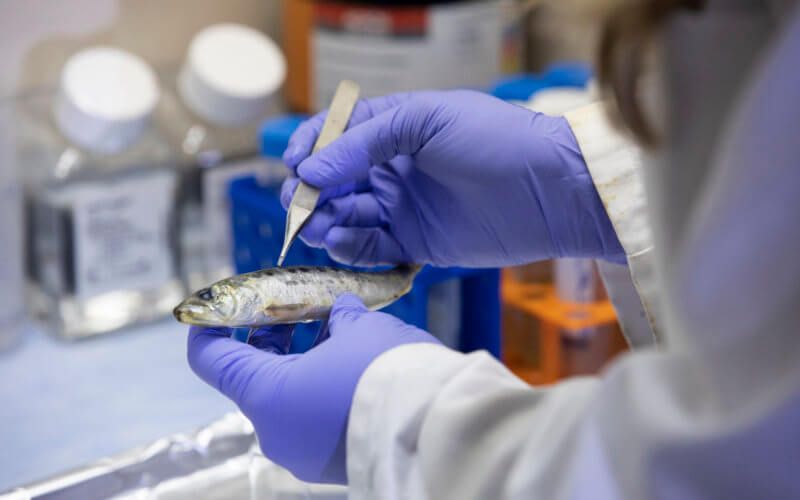
In a basement laboratory, Cal State Fullerton biology graduate student Chelsea Bowers dissects Pacific sardines and blends them into a creamy “shake.”
It won’t go well with a burger and fries, but her hope is that the concoction of sardine stomach and muscle tissues helps find solutions to international microplastic contamination of ocean life.
Bowers’ ongoing research studies how such marine pollution may be affecting Pacific sardines, an essential part of the oceanic food chain and a commercial food fish that ultimately leads to our dinner tables.
Her research, which aims to quantify ingested microplastics — the amount, size, and type — found in the sardines’ stomachs and muscle tissues, will help other scientists studying a growing and international microplastics problem.
A study by researchers from the Netherlands and New Zealand predicts that without proper handling or removal of already-accumulated plastic pollution, the world’s microplastics problem could double in size by the year 2050. Irish researchers found that 73% of deepwater fish in the north Atlantic Ocean had eaten particles of microplastics, while a Harvard study estimated 14 million tons of microplastics exist on the whole ocean floor.
Fishing for Answers
Bowers’ preliminary research findings show microplastic contaminants in wild-caught sardines.
“I’m finding microplastics in the stomachs and muscle tissues of the sardines, which is what you hope you don’t find,” she relayed. “These findings ultimately could help build the foundation for future research concentrating on physiological pathways of assimilated microplastics in sardines and potentially other fishes.”
Bowers, who expects to finalize her study next year, started collecting sardine samples in September 2019. While the pandemic stalled her work, she is now back in the lab — following university COVID-19 safety protocols — to dissect the sardines and analyze tissue samples.
The Pacific sardine is found along a stretch of curved coastline known as the Southern California Bight winding from Point Conception, near Santa Barbara, south to the U.S.-Mexico border and seaward toward the Channel Islands.
Bowers is specifically looking at Pacific sardines caught off the coast of Long Beach. This blue-greenish sardine, which can grow more than a foot long, is commonly used for bait, as well as for animal and human consumption. The small fish is prey for other marine life, including seabirds, and is found in local coastal waters, especially between the spawning months of August through October.
“Pacific sardines are filter feeders that feed on a variety of plankton in the same size range as marine microplastics and are vulnerable to ingesting microplastics,” Bowers said. “More and more plastics are being degraded into our coastal waters as a result of contamination from river run-off and wastewater.”
Misty Paig-Tran, associate professor of biological science and Bowers’ research adviser, noted that microplastics are either manufactured directly, such as plastic beads in exfoliating scrubs and toothpaste, or are broken down from larger plastics like Styrofoam food containers, straws, bottles, caps, and other plastic litter discarded by humans.
“These may be virtually undetectable to the human eye in the water, but they can be quite harmful to marine life,” she said.
About California State University, Fullerton
The largest university in the CSU and the only campus in Orange County, Cal State Fullerton offers 110 degree programs, and Division 1 athletics. Recognized as a national model for supporting student success, CSUF excels with innovative, high-impact educational practices, including faculty-student collaborative research, study abroad, and competitive internships. Our vibrant and diverse campus is a primary driver of workforce and economic development in the region. CSUF is a top public university known for its success in supporting first-generation and underrepresented students and preparing all students to become leaders in the global marketplace. Our It Takes a Titan campaign, a five-year $200 million comprehensive fundraising initiative, prioritizes investments in academic innovation, student empowerment, campus transformation, and community enrichment. Visit fullerton.edu.
###
Photo Caption: Cal State Fullerton graduate student researcher Chelsea Bowers is studying how microplastics are affecting Pacific sardines, an essential part of the oceanic food chain and a commercial food fish that ultimately leads to our dinner tables.
Additional assets including full story, photos, infographics, and videos are available.
Story: http://news.fullerton.edu/2021/08/sardines-tainted-with-microplastics/
Video: https://vimeo.com/592359270
Photos and infographics: https://www.dropbox.com/sh/s1bgq4wr5shmq90/AAC-dBjhWe_clZ4eCiFpKkZYa?dl=0